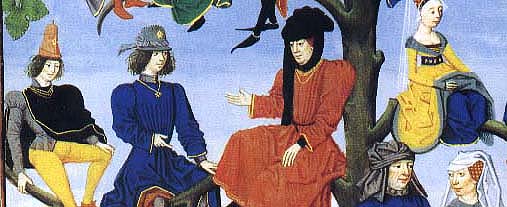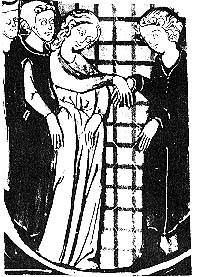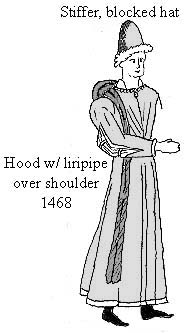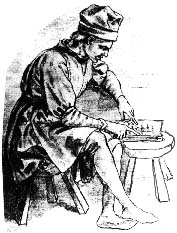
Some of the most silly hats that have ever been invented as serious
wear on this planet were in use during this time in Europe.
 First:
a few generalizations. If your outerclothing is loose and flowy, your headcovering
will likely be comprised of lots of fabric. If your clothing is tailored
and snug, your hat will also be more structured and formal. If you're wearing
one of the close fitting caps, you're either dressed in earlier period
costume, or else you're partially dressed (or in working dress) for the
14XXs. If you want to be absolutely certain that you are wearing the correct
hat, find a period illustration of what you want, and wear exactly what
is depicted: no-fuss accuracy!
First:
a few generalizations. If your outerclothing is loose and flowy, your headcovering
will likely be comprised of lots of fabric. If your clothing is tailored
and snug, your hat will also be more structured and formal. If you're wearing
one of the close fitting caps, you're either dressed in earlier period
costume, or else you're partially dressed (or in working dress) for the
14XXs. If you want to be absolutely certain that you are wearing the correct
hat, find a period illustration of what you want, and wear exactly what
is depicted: no-fuss accuracy!
This class addresses three main types of hats: close fitting caps of the early variety, hoods (covered in the handout "Hoodlum") and the sugar--sack type hat.
There are other types of hats which were worn, such as wide-brimmed straw hats for field work, medium-brimmed fur hats for hunting, specialized hats for ethnic or religious groups, and fantastical creations that may or may not be pure imagination. These I have not dealt with in this handout.
In addition, some of the taller sugar-sack type hats look as if they
require high-skill felt blocking techniques; I have not addressed these
either, as they are beyond my current knowledge. The ones shown here can
be made from common materials, such as linen or fulled wool. The pattern
shapes for these are my conjecture, except as noted. There are very few
extant garments from this time period. I'd be happy to hear of other sources
and information for these if you know of any.

 The
simplest of the hats is the close-fitting cap. This style is used in the
SCA as an arming cap, but is perfectly acceptable as outerwear for early
period clothing. It is also useful as a sleeping cap at camping events,
providing warmth and hair-control. It was also worn underneath rolled-up
hoods in the slightly later time periods, as these illustrations show,
and worn by women in some instances (sickbed being the only one that I
have found so far for the later times.)
The
simplest of the hats is the close-fitting cap. This style is used in the
SCA as an arming cap, but is perfectly acceptable as outerwear for early
period clothing. It is also useful as a sleeping cap at camping events,
providing warmth and hair-control. It was also worn underneath rolled-up
hoods in the slightly later time periods, as these illustrations show,
and worn by women in some instances (sickbed being the only one that I
have found so far for the later times.)
Usually this cap is of white material, but I have seen illustrations of red or green or brown as well.
Interestingly, in none of the illustrations that I have seen are the ties shown tied in a bow underneath the chin, or at the ear. One illustration, which I was unable to find in time for this class, shows a button fastening at one side with the thicker chin strap style, but as I can't prove this to you, it will have to remain conjecture.
The possibilities for fastening are thus:
1. Fastened with a bow, which no illustrator bothered to diagram.
2. Fastened with a bow, which was then tucked up under the ear flap
to remain hidden.
3. Fastened with a button, which no one diagrammed.
4. Cut so that it could be pulled onto the head without a tie or button,
like a pre-tied kerchief.
You can be the arbiter of which method you would like yours to follow.
Similarly, you can decide if you prefer the thin `string' ties as in some
of these pictures, or the thicker chin band pictured above with the bethrothal
scene.
Construction of this item is relatively simple; fold the fabric in half, cut the shape out (you can either leave the fold at the top, or cut the whole shape), and finish it with bias tape and/or ties. Be sure to measure your head first so that you have a good idea of what size you are aiming for. The end product *will* cover your ears; this will take a little getting used to, but is appropriate. (If this is too quick a description, see the longer article.)
The angle at the ear should be less than a 90' corner so that the front
of the cap falls slightly behind the average forehead line in front, and
above your hair line at the back of your head. The later style with a round
section in back as a separate piece, shows up in the mid-1500s and is not
covered in this handout.

 For
the later styles with short or long houppelandes, variations on the sugar-sack
hat (as well as the ever-present hood) are appropriate. See the picture
on the cover that shows men of different ages; the younger crew are wearing
this taller hat style; the older are wearing variations on the hood. Sugar-sack
hats can be tall and moderately stiff (like a fez, but more conical, and
usually as tall as your face from chin to hairline) shorter and crumpled,
rounded-top or squared-top. Some of them look like a beanie that has been
stretched; even to having the little "stem" at the apex.
For
the later styles with short or long houppelandes, variations on the sugar-sack
hat (as well as the ever-present hood) are appropriate. See the picture
on the cover that shows men of different ages; the younger crew are wearing
this taller hat style; the older are wearing variations on the hood. Sugar-sack
hats can be tall and moderately stiff (like a fez, but more conical, and
usually as tall as your face from chin to hairline) shorter and crumpled,
rounded-top or squared-top. Some of them look like a beanie that has been
stretched; even to having the little "stem" at the apex.
Earlier cotehardies were also worn with shorter rounded felted hats like this. They can be lined in contrasting wool, fur, or any other lining, and worn unfolded, or with the lining turned back to show as an upstanding band where the hat meets your head.
In some cases, a cap of this sort would be worn when the standard hood
was not being worn, or when the hood was only worn on the shoulders and
not up covering the head.
The hoods, when rolled up, and these sugar-sack hats often have an ornamental pin in the center front. Some of the tall ones will have a feather coming up from this pin as well.
All of the softer variety of these sugar-sack hats are easy to construct.
The simplest is a cylinder of thick wool with a round bottom. Turn up the cuff and set it on your head, and there you are!
Further refinements can be made by changing this basic cylinder to one that angles toward the top, like a cone-section, or one that has curved seams at the top to produce the rounded effect at the top. A variation for older men is a tall (i.e., face-height) slightly inverted cone shape.

The look of one of the very stiff hats (short or tall) can be made
by cutting the brim off of a commercial "cavalier" type hat; these are
often sold at large camping events. If you are feeling adventurous, you
can then make another hat out of the brim material. Or a folding frisbee.
If you have questions after the workshop, feel free to send me email.
| All material (c) 1999 Cynthia Virtue | Email Author with comments |
| Back to Virtue Ventures Main Page | Back to Article Index |